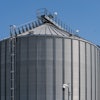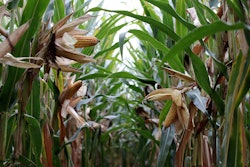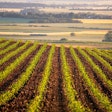Elise Schafer, editor of Feed & Grain: Hi, everyone, and welcome toFeed & Grain Chat. I'm your host Elise Schafer, editor ofFeed & Grain. This edition of Feed & Grain Chat is brought to you byWATT Global MediaandFeedandgrain.com. Feedandgrain.com is your source for the latest news,product and equipmentinformation for the grain handling and feed manufacturing industries.
Today, I'm joined on ZoomDr. Jan Dutton, CEO ofPrescient Weather Ltd. He's here today to discuss how this summer's weather could impact grain yields this harvest Hi, Jan, how are you?
Dr. Jan Dutton, CEO of Prescient Weather Ltd.:I'm great! How are you today?
Schafer:Doing well. Thanks for joining me. Right now, how has thisspring and summer weatherimpacted grain production and which regions were impacted the most?
Dutton: Yeah, that is a great question. If we go back to the spring, I will say t April had 79% of normal precipitation across US corn-growing regions and soybeans had 84%. And the northern portion of the Grainbelt received above normal precipitation. But pretty large areas were below normal rainfall.
And the same thing is true of May and June. Both were at right around the mid 70%, of normal rainfall for both corn and soybeans. And as we went further into the spring, the western portion of the Grainbelt started to receive more rain. But really what was most important for national grain production, the three “I” states (Illinois, Indiana and Iowa) were really quite low on precipitation for three months. And it started to create quite a lot of concern in the marketplace about what the potential outcome will be for 2023. And then as we went into July, it started raining across areas in the Midwest.
这是7月到目前为止,玉米和大豆cross the growing regions have received 105% of normal precipitation. That 105% is actually spread across some areas that remain dry — like Wisconsin so far has remained generally dry — and Michigan, for example, which has seen twice the normal precipitation. What’s really important for crops is that northern Illinois, which produces an awful lot of grain in the United States, has received 150% of normal precipitation. So, like our analysis shows, this year we’re not going to have a 2012 or a 1988 type year, but we're also not going to have a gangbuster year in terms of production, either.
Schafer:Interesting and really varied analysis there.
Dutton:Thank you.
Schafer:Now, what's in the weather forecast as we head into fall, and what are your predictions for 2023 end-of-season corn and soybean yields?
Dutton: Yeah, that is a great question. So right now, we are using some [World Climate Service]long-range forecasting tools, which provides a probability outlook of the next couple of weeks or the next four weeks. And we’re looking at colder than normal temperatures across much of the northern Grainbelt for the next two weeks. So, where it is exceedingly warm right now, it'll only be a couple of days long. And then it’s going to turn towards cooler than normal temperatures. And likewise, we should see slightly higher than normal rainfall over the next couple of weeks across key areas of the Grainbelt. It’s going to remain dry in the very deep South, and then as we head into the rest of August, we actually see drier conditions through August and warmer than normal conditions through August across much of the Grainbelt.
And then if we look even further ahead, in terms of, say a monthly outlook, there is anEl Niñooccurring in the tropical Pacific. And that helps provide some predictability. Although we are in a bit of a strange climate state while there's anEl Niñogoing on, there's actuallycooler than normal temperaturesin the in the Northern Pacific. And then it's been in the news thattemperatures in the Atlantic Ocean are substantially warmerthan normal. So that's actually a very unusual climate pattern, but what we see happening is the impact of the El Niño will be pretty important and the Upper Midwest will should stay cool and wetter than normal for the early part of the fall.
Schafer:With your unique climate analysis capabilities, can you predict how long theseEl Niño conditionsmight last?
Dutton: We don't have our own internal El Niño or La Niña prediction capability. What we can do though is look at the statistics of what has happened in the past. And so, there's a particular statistic called theEl Niño 3.4temperature, which measures the sea surface temperatures in a specific area of the tropical Pacific. So, in El Niños in the past, when they have occurred, the El Niño has been about nine months long, on average — the maximum being 17 months long.
And in fact, the most frequent occurrence for an El Niño is about eight months long. So given that we're about three months into warmer than normal SSTs (sea surface temperatures), which means that the current El Niño may last for another six to 12 months. If that's true, that means the El Niño will certainly hold through until the end of the year, possibly into the spring and even into next summer, as well. And if that occurs, then, you know, we would be talking about next summer being potentially wetter than normal if the El Niño holds true.
Schafer:So potentially some long-term consequences here.
Dutton:Indeed, yeah.
Schafer:So what advice do you have for green merchandisers and preparing for potential weather related supply disruptions?
Dutton:Yeah, so our analysis shows that the in terms of yields for the year, the for both corn and soybeans yields have mostly been set, they'll probably end up near trend conditions, we actually did a scenario analysis in which we took our yield model and ran prior years through it from from a few days ago. And it shows that there's still opportunities depending on the weather that happens for the grain yield to end up above or still below the the technology trend. So what that means for grain merchandisers is, it's really important to stay up and stay up to date on evolving weather conditions. So there are still possible yield changes left based on the conditions that are going to occur through the end of the season. And I think more in general, it's important to just remain aware of weather risks relative to crop crop reduction. You know, what I've experienced in talking with a lot of people in the industry is just through experience, people learn what the weather risks are. But we've also learned that sometimes people have the wrong concept or the wrong idea of how weather may impact the crops. And so then the best piece of advice that I can provide is just to make sure you have a way of quantifying the impact of weather on grain production and grain yields, to make sure that you're objectively getting the facts correct about about weather impacts.
Schafer:Well, Jan, thank you so much for your insights today!
Dutton:Thank you very much. I enjoyed it, and thank you for the opportunity to meet with you.
Schafer:是的,当然。这就是今天的提要和粒n Chat. If you'd like to see more videos like this, subscribe to our YouTube channel. Sign up for the industry, watch daily e newsletter, or go to feeding grain.com and search for videos. Thank you again for joining and we hope to see you next time.





















